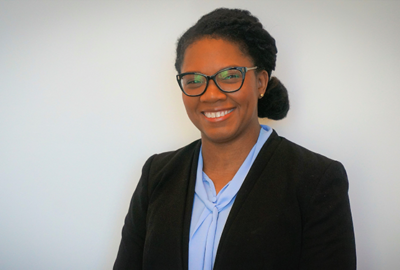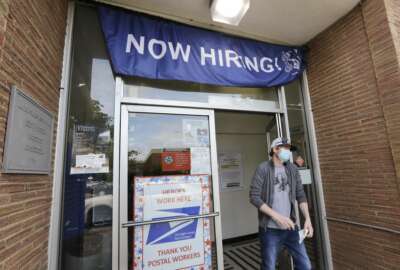
Managers must support employees dealing with stress during the pandemic
Managing director for Accenture Federal's human capital practice, Kristen Vaughan, joined Federal Drive with Tom Temin with some ideas.
Best listening experience is on Chrome, Firefox or Safari. Subscribe to Federal Drive’s daily audio interviews on Apple Podcasts or PodcastOne.
Federal managers have no problem supplying remote employees what they need to be effective. At least technically. But what about the whole person? Research by Accenture Federal Services shows the need to deal with the stress and pressure the pandemic has brought. Managing director for Accenture Federal’s human capital practice, Kristen Vaughan, joined Federal Drive with Tom Temin with some ideas.
Interview transcript:
Tom Temin: Miss Vaughn, good to have you on.
Kristen Vaughan: Thanks for having me, Tom. It’s nice to be here.
Tom Temin: And you did some fairly extensive research among people who are working under these crazy conditions we’re all working under. Tell us how you did that. And what are some of the top line findings?
Kristen Vaughan: Sure, we did. So we primarily focused to report on survey results from federal respondents, but we drew our underlying models using on global commercial sample. So we had a global initiative led by Accenture’s Chief Human Resource Officer Ellyn Shook, and also Marriott’s Chief Human Resource Officer David Rodriguez. We conducted findings and compare these to a global sample. For the study, we asked employees and CXOs to gauge a variety of factors. So things like degree employees felt “net better off,” employee trust and satisfaction with their employer, level of maturity and business practices in the workplace. We combine this data with how specific practices addressed fundamental human needs, and helping the employees become “net better off,” which then had a positive impact on both them and their employer […] on several global surveys, and there was a federal component to each one of those surveys, so we have about five different data points for all of those.
Tom Temin: And how would you describe in general the mind, or the state of mind, of the federal employees?
Kristen Vaughan: Federal workers took great pride in their role fighting the pandemic. Three out of four actually said their jobs have become more meaningful, if you can believe that. Also, to back that up, the 2020 Federal Employee Viewpoint Survey — FEVS — also found that federal worker’s experience and engagement scores were at their highest in five years. But at the same time, 68% felt increased stress. So you had more anxiety about a deteriorating work-life balance. And within six months of the pandemic hitting, half of federal leaders agree that their company should take a more active role in addressing these needs. So again, you have employees that are super engaged, but they’re also very stressed at the same time.
Tom Temin: And that stress makes you wonder if the widely purported increase in productivity is sustainable if something isn’t done about the stress.
Kristen Vaughan: Exactly, exactly. Some of the other important findings we found were that just half of federal workers believe that their full potential is being realized at work. So think about that. That’s a big number. So if employers can take better care of their workers, they can unlock unrealized potential. And better employees translates to greater trust, which can drive loyalty and productivity. And we found that companies that scored high and helping their employees become “net better off” earn higher levels of trust. So I think 97% trusted their employer, versus 52% with lower scores. So really implementing this “net better off” framework can also strengthen an agency’s Employer Value Proposition. This is what we call the EVP. It’s the perceived benefits from working for a specific organization.
Tom Temin: And that idea of getting more potential from people doesn’t mean more work out of them.
Kristen Vaughan: Correct. No, it’s tapping into things that are fundamental to them. So part of our research, we found five, what we call sweet spot practices, that can help companies achieve a better “net better off” with their employees. So the first one is “enable continuous learning.” So this is ensuring that you have a future ready workforce that can shift at scale. The second is “listen to what people need at the frontlines” — empowering people with real time data. The third is “using technology to enable flexible work arrangements.” And this allows for more creativity and collaboration in your workforce that’s dispersed and blended. Fourth is “champion workforce well-being.” So you think about safety and relational needs, these are more important than ever. And lastly, is “set and share specific people metrics.” So this is taking accountability for diversity and equality, and being transparent and engaging in intentional conversations that really matter to people. We have to be more purposeful with this blended and disconnected environment to really make sure that we’re taking a timeout for employees and checking out on their well-being.
Tom Temin: We’re speaking with Kristen Vaughan, she’s managing director for the human capital practice at Accenture Federal Services. And there’s one of those practices I wanted to ask you about. And that is “champion workforce well-being.” In the private sector, there’s a lot of things they can do, that sometimes cost a little money, to ensure well being. I know even where I work, there were a lot of measures taken throughout the pandemic, when most people were remote, and it was difficult, that really helped feel that connection with the company and feel that the powers that be care about me personally. But federal agencies operate in such a rigid structural set of rails of what they can do for people. What are some things you feel that an agency can do to “champion workforce well-being?”
Kristen Vaughan: What really surprised me was that government agencies were really super responsive to workforce well-being in the early stage of the pandemic and then throughout. They quickly set up wellness programs, counseling, flexible work arrangements, and over communicated on health and available support options. We also saw a change in policies and procedures. I think that’s what you’re hinting at, right? That it’s really hard to get around the red tape. So things like flexible work arrangements, new tools and technology to collaborate better and share ideas. So people had a chance to work in the office, work outside the office and still collaborate a lot. So I think over time, the government agency’s challenges are going to be to take these temporary fixes, and turning them into long term solutions. Because we’re not going to go back to normal, right? We’re going to go back to better, where it’s going to be a blended workforce. And how do you make sure that people that are at an agency — they’re in-person — also balanced out with people that are at home? And how do people get equal treatment, right? If you’re in front of your boss all the time, you might get more face time, you’re going to get more time to talk to them and expose yourself and your ideas. So how do we make sure that the people at home and remote don’t feel disconnected and feel like they’re not being supportive as much? So I think there’s a big opportunity here as well.
Tom Temin: And one of the practices is to set and share people metrics. Tell us more about setting and sharing people metrics?
Kristen Vaughan: Sure. So setting and sharing people metrics is really important. If it’s not tracked, it’s not important. And we want to make sure that diversity, equity, inclusion goals are included. So if agencies are trying to get to a certain level of diversity goals, or gender equality, those are published and shared with the workforce. It’s really important in these times that people feel connected. Usually people leave the workforce, not because of their pay, or because their salaries, it’s because of their boss, and they want to feel like they are with someone and they’re part of a community. I think feeling connected when you’re dispersed is very important. So again, the water cooler conversations go away in a remote environment. That going to lunch, grabbing coffee, stopping by someone’s desk. All that is harder to do now. And so it’s making that time to forge new relationships and set up time. No one wants to be on Zoom calls all day. But how do you balance that with making connections and checking in and making sure that people feel connected. And there are employee resource programs for people to participate in things that they see people like them, and they see people growing in their careers that are like them. How do we make sure that happens, and continue to grow and foster inclusion, equality and diversity?
Tom Temin: And there’s another wrinkle in agencies often, and that is the presence of large numbers of contractor employees. And of course, those are ultimately the responsibility of the contractors companies. But is there anything that an agency can do to make sure that for purposes of everybody getting along well, and getting the mission accomplished, that they can somehow include the contractor people on site in some of these activities?
Kristen Vaughan: Yes, absolutely. Contractors and government employees are coming together to form one team. So we’re not looking at it as what color is your badge, or contractor versus government, it has to be one team pushing out things and working together. Collaboration doesn’t happen in silos. And so we want to make sure that the collaboration, the co-creation all happens together, and people feel that they’re supported holistically through their teams. I think what we’ve seen a lot during the pandemic also is continuous learning. So people want to learn and not just learn for compliance. I’ve seen a big shift and government agencies where before the pandemic, they use training as a point in time where it was checking the box to make sure that you complete your annual training. And now I see it more as continuous learning to enable workforce improvement, knowledge gain, and using things like upskilling and reskilling on AI, cloud, cyber. Agencies are taking time to invest in their employees to gain these new skills. And I think they’ll come out stronger in the end, because the employees feel more engaged, and they’re also learning something new.
Tom Temin: And you have several examples in this latest report of federal agencies doing some of these five practices. And one I thought interesting was on practice [no.] 2, “listen closely to frontline workers,” you cite the U.S. Army using analytics to empower careers. Tell us about that particular one.
Kristen Vaughan: Sure. So using analytics to empower careers, we want to know what people are thinking and feeling. And if they feel like they don’t have a career path, or they are stuck in their job, we want to know that and enable those things. So as we look at the data for Army and other federal agencies, it’s looking at progression, it’s looking at attrition rates, it’s looking at how we can make people feel like they have a career path and a career trajectory and learning and growing our skills. People don’t want to feel like they’re stuck in one career service or one developmental path for the rest of their lives. So they want rotational programs, they want to learn and gain new skills. So having those insights and metrics from employees to pull together a cohesive picture of what’s the attrition rate, what are my high performers, we can use predictive analytics to look at all of that. So how do I make sure that those high performers stay engaged, and I can retain at my agency? And for lower attrition rates, how can I make sure that if I dive into attrition, are there certain job series that are attriting more to my organization than others? And what can I do to really hone in and put in programs or different support mechanisms in place to make sure that those people feel supported and rewarded?
Tom Temin: So these are practices really then all five of them and across the whole bureaucracy that should really continue pandemic or otherwise?
Kristen Vaughan: Exactly. And I think that’s why we’re really saying back to better. Because we want to make sure that we’re not going back to what we were before. But we’ve learned a lot about ourselves and our employees during this time. We found that it’s worth connecting, people want to feel connected. And I think before the pandemic we always used to talk about work-life balance, and I think we’ve all realized that it’s really life balance. Work is a part of life. You have your work and you have your personal life, and that all blends together with life. So how do we make sure that people feel balanced, and they can meet the needs from a flexibility perspective, from a personal and employer perspective, in order to get the best out of engagement and what they’re doing?
Tom Temin: Kristen Vaughan is managing director for the human capital practice at Accenture Federal Services. Thanks so much for joining me.
Kristen Vaughan: Thanks for having me, Tom.
Copyright © 2024 Federal News Network. All rights reserved. This website is not intended for users located within the European Economic Area.
Tom Temin is host of the Federal Drive and has been providing insight on federal technology and management issues for more than 30 years.
Follow @tteminWFED





